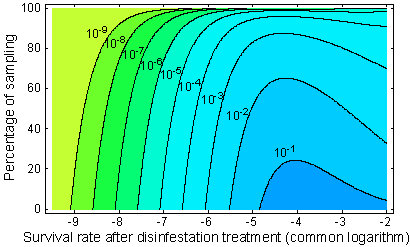The number of invasive species that were transported through imported commodities
is increasing exponentially. The practical measure to prevent the invasion
of
harmful organisms are a series of phytosanitary measures, such as the prohibition
of importation, disinfestation treatments of commodities, and sampling inspections
of consignments. However, these measures can be used as a non-tariff barrier
to trade in some countries, which may cause international conflicts. To prevent
such conflicts, the Agreement on Sanitary and Phytosanitary (SPS) Measures
of
the General Agreement on Tariffs and Trade (GATT) requires members to base
their animal, plant, and human health requirements related to trade on international
standards. These plant health measures are to be based on standards developed
under the auspices of the International Plant Protection Convention (IPPC),
implemented by the United Nations' Food and Agriculture Organization (FAO).
Although Pest Risk Analysis (PRA) is required in SPS agreement, the methodology
is not yet well established.
The probability of invasion via an imported consignment (that is denoted by Pt ) can be expressed by a general form:
Pt = P1P2,
where P1 is the probability that one or more individuals pass
the port to enter the county, P2 is the probability that the
entered individuals find suitable locations to establish their population. (P1 and P2 are not strictly independent.) The estimation of P2 is now in progress for each of the invasive species that are not yet invaded
but are suspected to invade in the future. However, the quantity of P2 contains too many uncertain components that are largely influenced by the fluctuation
of environmental characteristics of the destination country. In contrast, the
quantity of P1 can be estimated more precisely if we could
construct statistical models to describe the process of transportation. Hence,
the estimation of P1 seems to be practically more important
for making a political decision for quarantine procedures.
Although several methods have been proposed to estimate the quantity of P1 by
researchers in the US and New Zealand, these methods do not yield a precise
probability; these methods estimate P1 for a consignment imported from a single
site. In actual situations, however, many consignments are imported to a country
from various exporting sites that have different levels of infestation. We derived
a method to estimate P1 by using Bayesian approach. Figure
1 shows an estimated contour of P1 for Mexican fruit fly that has been of concern
in the citrus industry in the US.
The probability of invasion will not directly give us intuitive information
about whether the risk of invasion is large or not. The Expected Time required
for Invasion (abbreviated by ETI) will be a superior index to express the risk.
Let k be the number of consignments imported during a year. Then we approximately
obtain
ETI = 1/(kPt ) = 1/(kP1P2).
If we assume that P2 =10-5, k = 104 and ETI = 1000 years, for example, we obtain P1 = 10-2.
The contour of 10-2 in Figure 1 indicates that, for example, if we
inspect 40% of fruits after the disinfestation treatment, we can achieve ETI
= 1000 by using the disinfestation treatment with a survival rate of about 10-2.5.

Figure 1. Contour of the probability of invasion per consignment (P1)
for the Mexican fruit fly expressed as the function of the intensity of sampling
inspection and disinfestation treatment. The contour readily indicates the combination
of the percentage of sampling and the disinfestation treatment to achieve a given
probability of introduction. (Copyright by the Society of Population Ecology and
Springer-Verlag Tokyo)